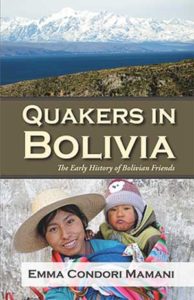Quakers in Bolivia: The Early History of Bolivian Friends
Reviewed by Jerry Mizell Williams
March 1, 2019
 By Emma Condori Mamani. Publicaciones CALA, 2017. 117 pages. $20/paperback.
By Emma Condori Mamani. Publicaciones CALA, 2017. 117 pages. $20/paperback.
Buy from the FUM Bookstore
When in 1919 Friends undertook missionary work in Bolivia, it was with Fox-inspired leadings and a decided conviction to succeed. Challenges came with planting a ministry on the heels of missions established by Methodists, Canadian Baptists, Seventh-Day Adventists, Catholics, and Protestants. Early Quaker missionaries had to contend with resistance and problems of language acquisition (Spanish, Aymara, and Quechua), native ancestral religious traditions and practices, the military, warring political factions, a feudal system, economic instability, and shortages of supplies and personnel.
Through the lens of an adult retrospective gaze, Emma Condori Mamani shares with readers recollections of Quechua family life, and her formative education through secondary school among Friends missionaries. She witnesses her parents and siblings contend with embracing Protestant (Friends) over Catholic worship. After a family tragedy, her mother becomes a convinced Friend, while Condori Mamani embarks on a spiritual journey of her own.
When young Condori Mamani attends Santidad Amigos (Holiness Friends) Yearly Meeting for the first time, she is convinced that she is nearing the stage of being “in the Spirit with God.” Enrollment in Manantial (Water Spring) Friends School, and afterward four years at Holiness Friends Yearly Meeting Bible School, leads to an experiential encounter with God, after which Condori Mamani begins to teach Bible school and toil as an evangelist. Encouraged by the presence of God within her, she ceases to feel oppressed as a woman and gathers strength as she navigates Bolivia’s patriarchal society and assumes a leadership role within it. She equates her Christian calling and responsibility to serve God with that of the first pioneers. Condori Mamani’s story ends when she graduates and contemplates relocating to La Paz to pursue higher education.
The author is at her best when describing how the overlapping roles of missionaries as educators, activists, and medical specialists attracted the native populace to worship:
Many Aymara people were drawn to Quakerism because Aymara Friends experienced the transforming power of God in their lives. Aymara converts . . . inspired the missionaries to do social justice work on a large scale among Bolivians. Through such efforts, the Aymaras felt the sparkle of the Holy Spirit. That is to say, for Aymaras, the Kingdom of God received in their heart was not hidden—it was lived out in their communities.
Condori Mamani’s sympathetic perspective dramatizes Quaker acceptance of the Aymaras’ capacity to embrace Christianity. Bolivia’s indigenous cultures served as the staging ground for proving that God’s grace was visible in the trials of Friends. Quaker missionaries, adept at demonstrating the presence of the Divine in human endeavors, revealed the creative hand of God as manifest on Bolivian soil.
Central to the history of Friends in Bolivia and Condori Mamani’s moving narrative are the original labors of stalwarts such as Mattie Blount, the Hinshaw family (former publisher Alva Holler and Sarah Mabel) from Kansas, Walter E. Langston and Emma Morrow, Esther Hunt, Emma Canaday, William Abel, and Helen Cammack, amongst others, who hailed from parts as diverse as Oregon Yearly Meeting, Central Yearly Meeting of Friends, Indiana Yearly Meeting, and Union Bible Seminary. It was not unusual for working relationships to result in marriages that further empowered commitments. The missionaries’ own body of testimonial prose enriches the content of the book. Print material played an advocacy role in engaging novitiates, and The Friends Minister (1913–1920), a semi-monthly periodical out of Union Bible Seminary, was most influential in raising funds for and extolling the virtues of mission work.
I was captivated by the fact that in 1920 the Hinshaws insisted on shipping a printing press to Sorata. The sheer volume of correspondence, books, diaries, articles, and reports that document those initial years underscores the effectiveness of the missionaries’ spiritual and literary campaign, and offers invaluable ethnographic data on indigenous beliefs and practices.
The third section of the book, “The Current Quaker Bolivian Community,” contains four interviews with Bolivian missionaries, followed by seven with Bolivian Friends leaders representing the country’s six yearly meetings. Despite the departure in 1975 of Friends missionaries, Bolivia possesses the third-largest Quaker community worldwide.
Notwithstanding controversies that arose in their missions, Friends in Bolivia broke through socio-cultural, political, and religious barriers. Condori Mamani’s personal story, informed by the rich legacy of turn-of-the-century pioneers, exemplifies the long reach of missionary labors within the framework of Quaker humanistic values.



Comments on Friendsjournal.org may be used in the Forum of the print magazine and may be edited for length and clarity.